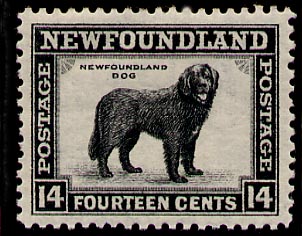
History

 |
Newfoundland History |
 |
Art in Newfoundland
(to 1949)
[This text was written in 1949. For the full citation, see the end of the text. Parts in brackets [...], images and links have been added by Claude Bélanger.]
For the most part, Newfoundland has left the painting of her rugged landscape to outsiders and to amateurs. She has produced no notable painters with the exception of Maurice Cullen and Robert Pilot, who went to Montreal years ago and established their reputations as Canadians rather than Newfoundlanders. Harold Goodridge might be added to the list, although he is not well known outside his native province. He has painted some vigorous water colors but his historical picture of Cabot on the eve of his departure for the new world in 1497, the property of the Newfoundland Historical Society and now hanging in Government House in St. John's, hardly raises him above the status of an amateur. Reginald Shepherd, who has just returned home with an excellent record as a student in the Ontario College of Art, is still a man of the future.
St. John's has had two art societies, one of them still active. There are dozens of dabblers and hundreds go to see their exhibitions; but the lack of an art school, of commercial studios and of a public gallery or any proper place to hang pictures has hindered the development of painting beyond the dabbling stage.
The same generalization may be drawn concerning sculpture. The national war memorial on King's Beach, where Sir Humphrey Gilbert is supposed to have taken possession of the island for Britain in 1583, is the work of two Englishmen, F. V. Blunderstone and Gilbert Bayes. The statue of "The Fighting Newfoundlander" in Bowring park is the work of another outsider, Basil Gotto, and the "Peter Pan" is of course the Peter Pan of Kensington Gardens . The bronze profile on the memorial shaft to Capt. "Bob" Bartlett at Brigus was modelled by J. R. Ewing, a St. John's furrier who was the last president of the Newfoundland Society of Art. Mr. Ewing disclaims any right to call himself a sculptor, though the relief is recognized as a good likeness of the famous mariner and the monument is impressive in its native simplicity and dignity.
Fifty years ago, the Ladies' Reading Room and Current Events Club, later called the Old Colony Club, came into existence. At the end of the first war, its energies spent on campaigning for women's suffrage and on war work, it languished. In order to revive interest and raise funds, its president, Mrs. McNeil, organized an art exhibition, the first to be held in St. John's since the annual shows given by the pupils of a teacher named Nicholls twenty years before. The exhibitors were amateur painters: Mrs. McNeil herself, Mrs. William Gilbert Gosling, whose husband was at one time mayor of the city and whose monument is the Gosling Memorial Library, and A. E. Harris, manager of the Anglo-Newfoundland Development Company at Grand Falls. A painter of more than ordinary interest was Miss Gwen Mewx (now Mrs. Waldrop of Colorado ) who introduced the public to cubism.
With .the formation of the Newfoundland Society of Art, there was a spurt of activity. Exhibitions were sent to eastern Canada, through the co-operation of Elizabeth Nutt, and a group of pictures was shipped to the Imperial Institute at Kensington. After some years of usefulness, the society over-reached itself in an ambitious project having more to do with patriotism than art, and collapsed. It commissioned a Newfoundland painter named John Vincent, living abroad, to paint a portrait of His Majesty King George V. The portrait was exhibited and reproductions were sold throughout the island, but the society could not meet its obligations. There is a move to revive the Newfoundland Society of Art. Meanwhile, it has been succeeded by the St. John's Art Club, founded in 1940 by Mrs. A. C. Hunter. The club, which is a loosely knit organization, without a constitution, has forty active members and eighty associates. Monthly meetings in the homes of members are given over to illustrated talks and discussions. Mrs. Hunter conducts an art appreciation group and Miss Sadie Organ is president. The club has a circulating library of art books, and pictures are lent to the members without payment of rent. Two exhibitions are sponsored by the club each year: one is of reproductions, from Mrs. Hunter's private collection; the other is of original painting by native Newfoundlanders and visiting painters who are always invited to become members. During World War II the club organized an exhibition of the work of men in the armed services, and the annual shows usually contain contributions from the American bases still in Newfoundland . The public exhibitions are held in the Memorial University College , in the Queen's College Library and in the Memorial College Annex. One of the most successful was hung in the windows of a departmental store on Water Street . Due to the war and to lack of facilities and funds, exhibitions from outside the province have been infrequent.
Teachers in training at the Memorial University College are given instruction in methods of teaching drawing and painting in the public schools, and lectures in art appreciation are given regularly, the College's Carnegie art reference set being drawn upon for the purpose. Memorial College has not attempted to go further, and while St. John's has had a few private teachers, themselves amateurs, the lack of an art school has been a serious disability. In the fall of 1949, however, Reginald Shepherd and his wife Helen Parsons, both accomplished artists, opened a school known as the Newfoundland Academy of Art.
Source: Robert AYRE, "Art", in W. Stewart WALLACE, The Encyclopedia of Canada. Newfoundland Supplement, Toronto, University Associates of Canada, 1949, 104p., pp. 3-4.
© 2004 Claude Bélanger, Marianopolis College |